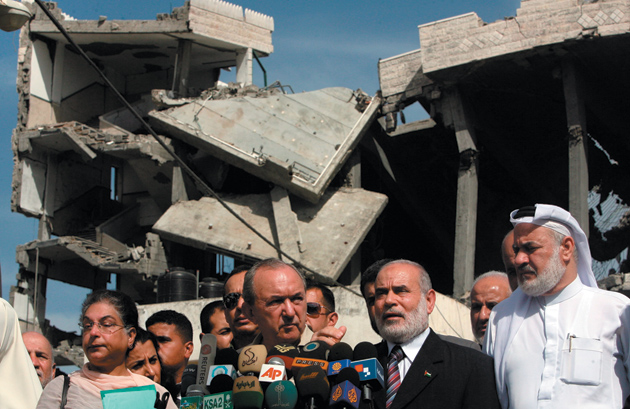In response to:
Goldstone and Gaza: What's Still True from the May 26, 2011 issue
To the Editors:
David Shulman’s article “Goldstone and Gaza: What’s Still True” [NYR, May 26] ignores the implications of Richard Goldstone’s stunning mea culpa. After reviewing Israel’s recent Gaza investigations, Goldstone declares: “If I had known then what I know now, the Goldstone Report would have been a different document.” On the key issue of intentionality, he concludes that “civilians were not intentionally targeted as a matter of policy” by Israel.1
Mr. Shulman, conceding that Goldstone was right to make that correction, states that “anyone who knows the Israeli army knows that, for all its faults and failings, it does not have a policy of deliberately targeting innocent civilians.” But Mr. Shulman is curiously unwilling to follow the logic of that statement. Since war crimes require intent to injure civilians, it follows that all the charges against Israel collapse. Mark Toner, spokesman for the State Department, thus declared that the government did not see evidence of “any” war crimes and “now we see that Justice Goldstone has reached the same conclusion.”2
Similarly, Human Rights Watch’s executive director, Kenneth Roth, now acknowledges that the incidents cited in two of his organization’s three Gaza reports are “too isolated for us to conclude that the misconduct of individual soldiers reflected a wider policy decision to target civilians.”3 Those reports cover 80 percent of the fifty-two alleged civilian casualties identified by HRW.
While agreeing with Goldstone’s retraction, Mr. Shulman fails to recognize that there is no longer a legal basis for charging Israel with war crimes. As a result, he complains about Israel’s attack on armed Gaza police officers, claiming they were passive bystanders and not part of Hamas’s military apparatus. But Hamas’s final casualty figures include the police as combatants.
Mr. Shulman also raises general concerns about civilian suffering but overlooks the circumstances in which the conflict was waged. Hamas disguised its fighters in civilian garb, hid its troops and weapons among civilians in densely populated areas, and used civilians as human shields. It deliberately placed Gaza’s citizens in harm’s way. Accidental damage to civilians was inevitable despite the best precautions to minimize collateral damages. It was Hamas’s goal to win a public relations victory by exploiting pictures of civilian suffering.
I share Mr. Shulman’s concerns about Israel’s prolonged occupation, settlements, and lack of progress in peace negotiations. But when individuals like Mr. Shulman and powerful NGOs like HRW portray Israel as a pariah state, they are polarizing the parties and creating a poisonous atmosphere inhospitable to peace negotiations. They are making matters worse, not better.
Stuart Robinowitz
The author is a retired partner and of counsel to Paul, Weiss, Rifkind, Wharton & Garrison LLP and was formerly an adjunct faculty member at the Yale Law School. A longtime supporter of Human Rights Watch, he led human rights fact-finding missions for HRW and the American Bar Association.
David Shulman replies:
There is considerable difference between holding Israel to account for its policies and actions in Gaza in December 2008–January 2009 and seeking to “portray Israel as a pariah state.” Indeed, were the State of Israel to assume responsibility for what its army did in Gaza, and were it to transform its policy toward Palestinians into something that was minimally rational, constructive, and humane, it would soon emerge from the overwhelming isolation it now suffers in the international arena.
Mr. Robinowitz cites my statement denying that the Israeli army deliberately targets civilians as a matter of policy. Goldstone’s retraction largely focuses on this point and should be welcomed. This does not, however, mean that there were no cases of wrongdoing in Operation Cast Lead or that charges of war crimes simply collapse. Given the high civilian casualty figures and the overall level of destruction, the results of the army’s internal investigations of such charges are, in my view, perfunctory and far from convincing. (The precise figures, as compiled by B’Tselem, are given in my piece.) Many specific cases—such as the killing of the handcuffed, unarmed Iyad al-Samouni on January 5, 2009, to mention but one example—remain unsolved. I have little confidence that the army intends to investigate these cases with the seriousness they deserve; nor do I think that we are talking only about rare and episodic aberrations. Nonetheless, I repeat: it is wrong to posit a deliberate army policy of targeting civilians.
To the best of my knowledge, Human Rights Watch never claimed that such a policy existed. It is thus misleading to suggest that HRW has “now” retreated from such a claim.
Moreover, the absence of a policy to kill civilians deliberately is not enough; actions that inevitably result in high civilian casualties, and that follow from premeditated decisions on the part of the army command, remain crimes of war. In my view, the extensive use of white phosphorus and the heavy artillery bombardments in densely populated areas of Gaza—both amply documented during Operation Cast Lead—clearly fall into this category.
Advertisement
There is also the charge, which figures prominently in the Goldstone report (Chapter XIII), that Israel deliberately targeted civilian infrastructures in Gaza, perhaps in order to punish the civilian population collectively. Here the evidence is, unfortunately, all too persuasive. Mr. Robinowitz can decide for himself whether, for example, the targeting of a major water and sewage disposal installation at al-Sheikh Ejlin, serving the huge civilian population of Gaza City, does or does not constitute a crime. The Israeli veterans’ peace group Breaking the Silence has collected credible testimonies in which soldiers describe participating in such so-called “infrastructure work.” Note that Goldstone has not retracted the harsh conclusion to this chapter in his report.
Far from overlooking the context in which the war was waged, I have argued that this context determines the moral issues at stake. Fighting that takes place in the midst of a civilian population requires judgment and, sometimes, unavoidable risk on the part of the individual soldier and of his or her commanding officers. One can complain about the ugly exigencies of such a war; they are, however, not new to Israel’s experience. My claim, on the basis of direct testimonies from soldiers who took part in the Cast Lead campaign, is that previously accepted rules of engagement were changed and that a “zero-risk” policy was adopted—for the first time in Israel’s history. In effect, this can only mean greater civilian casualties. Mine is by no means the only Israeli voice protesting the new modus operandi as falling short of the ethical standard that the army had hitherto set as its norm (even if it sometimes, perhaps often, failed to live up to this norm).
One should not dodge the moral question by speaking of “accidental damage to civilians,” or by refusing to acknowledge that many innocents died in the deliberate attack on the police cadets in the opening moments of the war, or, more generally, by ignoring the consequences of the tremendous firepower unleashed by Israel during the operation. What is worse, none of the above can be isolated from the current wave of nationalist hysteria, racist legislation, self-righteous posturing, and self-destructive policies that has engulfed the State of Israel and now informs much of its public discourse—including official statements by government spokesmen, the Foreign Ministry, and many members of the Knesset. Such statements and the actions they seek to justify or defend are the true cause of the present “poisonous atmosphere inhospitable to peace negotiations.”
-
1
Richard Goldstone, “Reconsidering the Goldstone Report on Israel and War Crimes,” The Washington Post, April 1, 2011. ↩
-
2
Associated Press, as reported in “Goldstone Says He Won’t Seek Nullification of Gaza War Report,” Haaretz, April 6, 2011. ↩
-
3
Kenneth Roth, “Gaza: The Stain Remains on Israel’s War Record,” The Guardian, April 5, 2011. ↩




